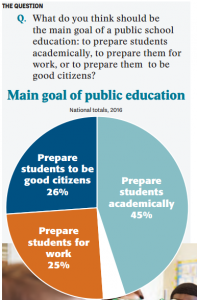We are just back from a vacation in parts of Iceland, Denmark, and Sweden. Although I’ve been in the region before, I am very far from expert on Nordic politics and economics. But it’s worth understanding the Nordic model–even if it looks a little rickety today and may depend on factors that couldn’t transfer to the US–because basic measures of human well-being are extraordinarily high in the five Scandinavian nations. For instance, Norway has the highest human development level in the world. I think the Nordic model represents a fusion of two contrasting impulses, a combination that is perhaps obscured in talk about social democracy or democratic socialism.
The (conservative) Heritage Foundation’s Index of Economic Freedom makes the point. From Heritage’s perspective, Denmark is an odd mix, although its overall rank is high. Heritage considers Denmark very bad at “limited government,” because one aspect of the Nordic model is high taxation and spending. On the other hand, Heritage ranks Denmark very high on measures like business freedom, investment freedom, and property rights (as well as freedom from corruption, which everyone values).
I think the Nordic model boils down to competitive entrepreneurship in the global marketplace plus strongly egalitarian social policies for everyone in the home country. Scandinavians are out and about, learning foreign languages (95% of Swedes speak English), and studying and working overseas. Goods as well as human beings flow across their borders. Denmark’s international trade is 102% of GDP. I’m not certain how that number can be greater than 100%, but the ratio is obviously much higher there than in the US, where trade is 27% of GDP. You see imports everywhere in Scandinavian stores, as well as export-oriented businesses.
Competitiveness brings material benefits: high-quality goods and services selected from around the world. It provides opportunities for ambitious and talented people to create new things. An index of innovation ranks Sweden first in the world, and Finland and Denmark are also in the top 10. Competition also identifies and rewards excellence. The result is a lively, flexible, future-oriented society. Scandinavians are proud of their nations’ marquee industries and are notably patriotic without being bellicose.
At the same time, competitiveness hurts people–the people who cannot or don’t happen to win, who were doing fine before all the market “disruptions,” who value traditions, or who don’t even want to fight for success in market economies. Competition can also erode civic virtues and responsibilities, including concern for public institutions and shared resources.
That’s why the other side of the Nordic model is so important. At home, everyone has very extensive and unconditional economic rights, which cost a lot of money. The public sector budget is 55% of GDP in Denmark. The state also demands people’s time and attention. Sweden, Denmark, Iceland, and Denmark all rank in the top seven for voter turnout, they have among the highest rates of associational membership in the world, and their governments are rated as the least corrupt.
All of this is hard to build and maintain, and I have not mentioned the drawbacks and frailties of the model. My point is really an ideological one. There are genuine virtues to systems that we might call “neoliberal,” systems that involve property rights, competition, and globalization. Strongly democratic societies that protect everyone’s welfare also have virtues. And although these goals can trade off in some respects, it’s possible to pick elements from the neoliberal menu and others from the socialist menu without contradiction.
